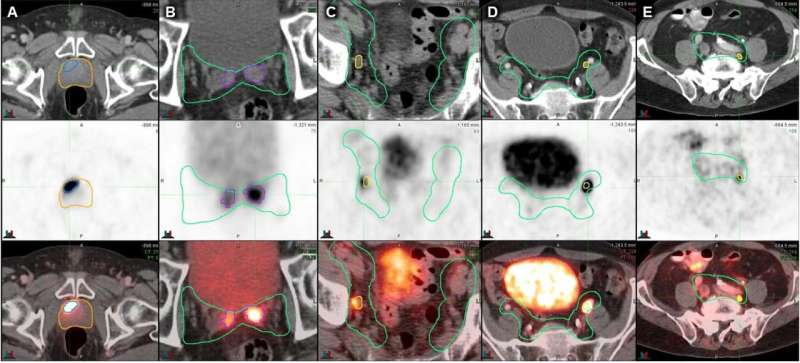Prostate cancer radiotherapy more precisely targeted with nuclear medicine imaging

Current standard imaging techniques for initial staging of prostate cancer often underestimate the extent of disease beyond the prostate. A study featured in The Journal of Nuclear Medicine's November issue demonstrates that prostate-specific membrane antigen (PSMA) positron emission tomography/computed tomography (PET/CT) can pinpoint prostate cancer locations with superior accuracy. More accurate detection makes more precisely targeted treatment possible. Men with non-metastatic disease who chose radiotherapy could, therefore, improve their chances of a successful outcome with PSMA PET/CT imaging to more accurately define the areas targeted for irradiation.
"The planning of radiotherapy for prostate cancer starts with precise delineation of the anatomic targets for delivery of radiotherapy," explains Nicholas G. Nickols, MD, Ph.D., of UCLA and the VA Greater Los Angeles Healthcare System in Los Angeles, California. "The prostate is always included in the irradiated volume, but there is currently no consensus about whether pelvic lymph nodes that appear to be free of cancer on standard imaging should also be irradiated." He states, "Incorporation of PSMA PET/CT into the process of radiotherapy planning might improve the success rate of curative-intent prostate radiotherapy by identifying patients with occult (invisible to conventional imaging) metastatic disease or local (pelvic) disease that is not visible on conventional imaging and modifying target volumes and dose to adequately cover and control local disease."
In this project, 73 patients with localized prostate cancer and no prior local therapy underwent gallium-68 (68Ga)-PSMA-11 PET/CT scans. All patients had PSMA-positive primary prostate lesions. In addition, 25 of the 73 (34 percent) had PSMA-positive pelvic nodal metastases, and 7 (9.5 percent) had PSMA-positive distant metastases. PSMA-positive lesions not covered by planning volumes based on the clinical target volumes from standard imaging were considered to have a major potential impact on treatment planning.
Nickols reports, "We found that addition of the information from PSMA PET/CT to standard imaging had a major impact on the planning of curative-intent prostate radiotherapy for 16.5 percent to 37 percent of patients, depending on if one initially elects to target pelvic nodes that are free of disease on conventional imaging." He adds, "These findings represent another convergence of molecular imaging and precision radiotherapy. PSMA PET/CT offers unprecedented accuracy and sensitivity for detecting the location of prostate cancer within a patient, and modern radiotherapy offers a non-invasive and generally safe method for delivering a tumoricidal dose of radiotherapy to the targeted cancer."
More information: Jeremie Calais et al, Potential Impact of 68Ga-PSMA-11 PET/CT on the Planning of Definitive Radiation Therapy for Prostate Cancer, Journal of Nuclear Medicine (2018). DOI: 10.2967/jnumed.118.209387



















